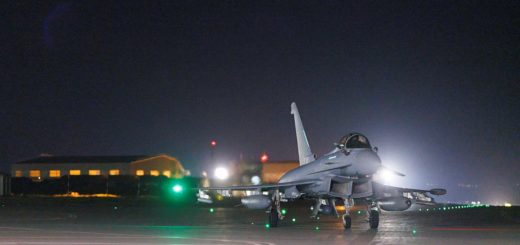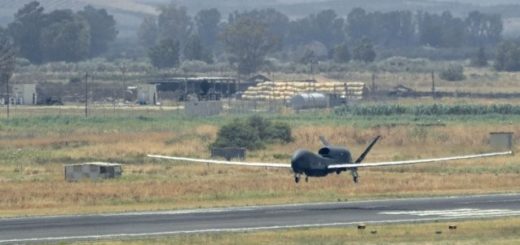Ukraine Converts Zlin Z-137 Crop Duster Into R-73 Air-to-Air Missile Platform To Counter Drone Threat
{loadposition bannertop}
{loadposition sidebarpub}
On August 8, 2025, as reported by OSINT group Tysk from Telegram, new footage has emerged showing one of Ukraine’s most unconventional air defense solutions to date, a Zlin Z-137 Agro Turbo agricultural aircraft equipped with two R-73 infrared-guided air-to-air missiles. The sighting underlines Kyiv’s ongoing strategy of adapting available civilian platforms into improvised military systems, aiming to counter the growing threat of slow, low-flying drones such as Russia’s Shahed/Geran-2. The development also demonstrates Ukraine’s ability to integrate legacy missile stocks into new roles, in line with its broader innovation trend in air defense.Follow Army Recognition on Google News at this link
Ukraine’s Z-137 modification embodies a wartime reality in which necessity drives unconventional innovation, turning a legacy agricultural aircraft into a functional element of the country’s air defense network. Whether it ultimately sees combat or remains experimental, the project reflects a broader pattern of adapting R-73 missiles for use across fighters, improvised ground systems, and naval drones (Picture source: Tysk Telegram-group)
The Zlin Z-137, originally a Czechoslovakian-built turboprop crop duster introduced in the 1980s, was designed for low-speed, low-altitude agricultural operations, characteristics that now make it an ideal platform for intercepting unmanned aerial vehicles operating at similar flight profiles. The variant seen in the video has received a military-style gray paint scheme with white fuselage recognition stripes to mitigate the risk of friendly fire. Its armament consists of a single R-73 missile under each wing, complemented by two cylindrical stores mounted inboard, which could be fuel tanks or remnants of its original crop-spraying role. The R-73, known to NATO as the AA-11 Archer, is a short-range, high-off-boresight missile with a seeker capable of engaging targets at angles up to ±75 degrees, giving it flexibility against maneuvering drones. This missile has served as Ukraine’s main short-range interceptor on MiG-29 and Su-27 fighters, and more recently in improvised ground-based and naval platforms such as the “Gravehawk” containerized SAM system, modified 9K33 Osa vehicles, and the Sea Dragon unmanned surface vessel.
Ukraine’s use of R-73 missiles on unconventional launch platforms is part of a broader operational pattern seen since the start of the full-scale war. While MiG-29 and Su-27 fighters remain the primary users, these missiles have been successfully integrated into mobile SAM systems and even USVs, with confirmed kills against Russian Mi-8 helicopters over the Black Sea. The Z-137 conversion fits into this lineage, offering a low-cost airframe with minimal runway requirements that could patrol and respond to drone incursions without tying up more expensive fighter assets. Compared to purpose-built counter-UAV systems such as the U.S.-made VAMPIRE, which employs cheaper APKWS laser-guided rockets, the armed crop duster’s approach is more expensive per shot but potentially faster to implement given Ukraine’s existing R-73 stockpile. This adaptation also recalls the U.S. Air Force Special Operations Command’s OA-1K Skyraider II, itself derived from the Air Tractor AT-802 crop duster, though the American program is aimed at light attack and ISR roles rather than dedicated counter-drone missions.
The strategic implications of this conversion extend beyond its immediate tactical role. By repurposing an obsolete agricultural aircraft into an active combat platform, Ukraine is demonstrating to both allies and adversaries that it can leverage any available asset to sustain its defense. From a geopolitical standpoint, such improvisations highlight Kyiv’s capacity for asymmetric adaptation, a quality that complicates Russian operational planning by introducing unconventional aerial threats that are difficult to anticipate. Militarily, this also serves as a proof of concept for integrating high-value missiles onto low-cost airframes, a model that could inspire other nations facing persistent drone threats but lacking sufficient fighter jet availability. In operational terms, Ukraine’s continued deployment of the R-73 across manned aircraft, ground vehicles, and naval drones illustrates a unique diversification of missile employment unmatched in current conflicts.
Ukraine’s Z-137 modification embodies a wartime reality in which necessity drives unconventional innovation, turning a legacy agricultural aircraft into a functional element of the country’s air defense network. Whether it ultimately sees combat or remains experimental, the project reflects a broader pattern of adapting R-73 missiles for use across fighters, improvised ground systems, and naval drones. Applying this approach to a low-cost, low-speed turboprop signals that every available airframe, from high-performance jets to crop dusters, can be repurposed against modern aerial threats. This not only complicates Russian planning but also offers a proof of concept for other nations seeking adaptable counter-drone solutions. In a war where rapidly fielding capabilities can shape outcomes, the armed Z-137 stands as both a symbol and a practical example of Ukraine’s resourcefulness.

{loadposition bannertop}
{loadposition sidebarpub}
On August 8, 2025, as reported by OSINT group Tysk from Telegram, new footage has emerged showing one of Ukraine’s most unconventional air defense solutions to date, a Zlin Z-137 Agro Turbo agricultural aircraft equipped with two R-73 infrared-guided air-to-air missiles. The sighting underlines Kyiv’s ongoing strategy of adapting available civilian platforms into improvised military systems, aiming to counter the growing threat of slow, low-flying drones such as Russia’s Shahed/Geran-2. The development also demonstrates Ukraine’s ability to integrate legacy missile stocks into new roles, in line with its broader innovation trend in air defense.
Follow Army Recognition on Google News at this link
Ukraine’s Z-137 modification embodies a wartime reality in which necessity drives unconventional innovation, turning a legacy agricultural aircraft into a functional element of the country’s air defense network. Whether it ultimately sees combat or remains experimental, the project reflects a broader pattern of adapting R-73 missiles for use across fighters, improvised ground systems, and naval drones (Picture source: Tysk Telegram-group)
The Zlin Z-137, originally a Czechoslovakian-built turboprop crop duster introduced in the 1980s, was designed for low-speed, low-altitude agricultural operations, characteristics that now make it an ideal platform for intercepting unmanned aerial vehicles operating at similar flight profiles. The variant seen in the video has received a military-style gray paint scheme with white fuselage recognition stripes to mitigate the risk of friendly fire. Its armament consists of a single R-73 missile under each wing, complemented by two cylindrical stores mounted inboard, which could be fuel tanks or remnants of its original crop-spraying role. The R-73, known to NATO as the AA-11 Archer, is a short-range, high-off-boresight missile with a seeker capable of engaging targets at angles up to ±75 degrees, giving it flexibility against maneuvering drones. This missile has served as Ukraine’s main short-range interceptor on MiG-29 and Su-27 fighters, and more recently in improvised ground-based and naval platforms such as the “Gravehawk” containerized SAM system, modified 9K33 Osa vehicles, and the Sea Dragon unmanned surface vessel.
Ukraine’s use of R-73 missiles on unconventional launch platforms is part of a broader operational pattern seen since the start of the full-scale war. While MiG-29 and Su-27 fighters remain the primary users, these missiles have been successfully integrated into mobile SAM systems and even USVs, with confirmed kills against Russian Mi-8 helicopters over the Black Sea. The Z-137 conversion fits into this lineage, offering a low-cost airframe with minimal runway requirements that could patrol and respond to drone incursions without tying up more expensive fighter assets. Compared to purpose-built counter-UAV systems such as the U.S.-made VAMPIRE, which employs cheaper APKWS laser-guided rockets, the armed crop duster’s approach is more expensive per shot but potentially faster to implement given Ukraine’s existing R-73 stockpile. This adaptation also recalls the U.S. Air Force Special Operations Command’s OA-1K Skyraider II, itself derived from the Air Tractor AT-802 crop duster, though the American program is aimed at light attack and ISR roles rather than dedicated counter-drone missions.
The strategic implications of this conversion extend beyond its immediate tactical role. By repurposing an obsolete agricultural aircraft into an active combat platform, Ukraine is demonstrating to both allies and adversaries that it can leverage any available asset to sustain its defense. From a geopolitical standpoint, such improvisations highlight Kyiv’s capacity for asymmetric adaptation, a quality that complicates Russian operational planning by introducing unconventional aerial threats that are difficult to anticipate. Militarily, this also serves as a proof of concept for integrating high-value missiles onto low-cost airframes, a model that could inspire other nations facing persistent drone threats but lacking sufficient fighter jet availability. In operational terms, Ukraine’s continued deployment of the R-73 across manned aircraft, ground vehicles, and naval drones illustrates a unique diversification of missile employment unmatched in current conflicts.
Ukraine’s Z-137 modification embodies a wartime reality in which necessity drives unconventional innovation, turning a legacy agricultural aircraft into a functional element of the country’s air defense network. Whether it ultimately sees combat or remains experimental, the project reflects a broader pattern of adapting R-73 missiles for use across fighters, improvised ground systems, and naval drones. Applying this approach to a low-cost, low-speed turboprop signals that every available airframe, from high-performance jets to crop dusters, can be repurposed against modern aerial threats. This not only complicates Russian planning but also offers a proof of concept for other nations seeking adaptable counter-drone solutions. In a war where rapidly fielding capabilities can shape outcomes, the armed Z-137 stands as both a symbol and a practical example of Ukraine’s resourcefulness.







